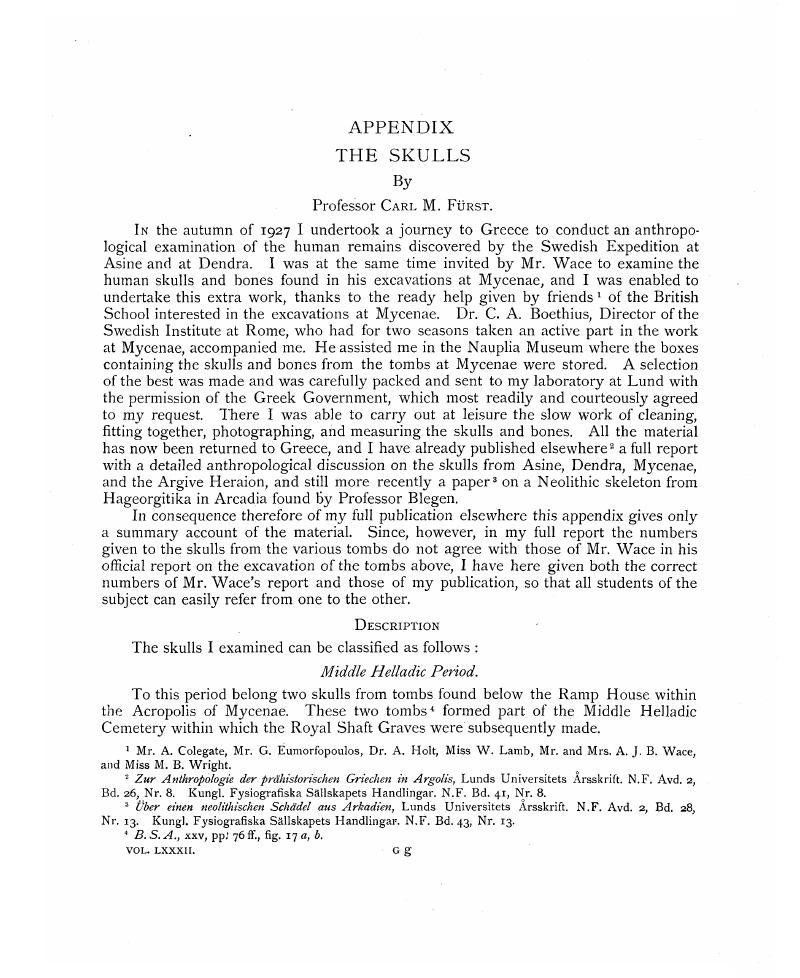No CrossRef data available.
Article contents
Abstract

- Type
- Other
- Information
- Copyright
- Copyright © The Society of Antiquaries of London 1932
References
page 225 note 1 Mr. A. Colegate, Mr. G. Eumorfopoulos, Dr. A. Holt, Miss W. Lamb, Mr. and Mrs. A. J. B. Wace, and Miss M. B. Wright.
page 225 note 2 Zur Anthropologie der prähistorischen Griechen in Argolis, Lunds Universitets Årsskrift. N.F. Avd. 2, Bd. 26, Nr. 8. Kungl. Fysiografiska Sällskapets Handlingar. N.F. Bd. 41, Nr. 8.
page 225 note 3 Über einen neolithischen Schädel aus Arkadien, Lunds Universitets Årsskrift. N.F. Avd. 2, Bd. 28, Nr. 13. Kungl. Fysiografiska Sällskapets Handlingar. N.F. Bd. 43, Nr. 13.
page 225 note 4 B. S. A., xxv, pp 76 ff., fig. 17 a, b. VOL. LXXXII.
page 226 note 1 B.S.A., xxv, p. 77, fig. 176; Fürst, Anthropologie prähistorischen Griechen in Argolis, pp. 37 ff., figs. 20–3.
page 226 note 2 B.S.A., xxv, p. 77, fig. 17 a; Fürst, op. cit, p. 41.
page 226 note 3 This and the similar references given for the following skulls are in every case to my Zur Anthropologie der prähistorischen Griechen in Argolis already mentioned above.
page 230 note 1 Fürst, Anthropologie prähistorischen Griechen in Argolis, p. 16, no. 4 F.A.
page 230 note 2 Fürst, Über einen neolithischen Schädel aus Arkadien, p. II f. Duckworth has published a male neolithic skull from Tsangli in Thessaly (Man, 1911, no. 35, p. 49), which is mesaticranic and has a length-breadth index of 76.9.
page 230 note 8 Fürst, Anthropologie prähistorischen Griechen in Argolis, pp. 12 ff.
page 230 note 4 Similarity of skull types need not necessarily imply that Asine was a Cretan colony, but only that there was a racial affinity between the population of Asine and that of Crete. In the Middle Helladic period there was little archaeological connexion between the Mainland and Crete. Archaeologically the Early Helladic people of the Mainland were akin to the Early Minoan people of Crete and the Early Cycladic people of the islands, and the view that at the beginning of the Bronze Age the E.H. people arrived in the Mainland by way of the islands is widely accepted by archaeologists (Cambridge Ancient History, 1, pp. 603 ff., B. S. A., xxii, p. 180; Blegen, A.J.A., xxxii, pp. 149 ff.; Persson, Asine, pp. 169 ff.; Ridgeway, Early Age of Greece, ii, p. xxvi; Cambridge Companion to Greek Studies 4, p. 247). Descendants of the E.H. people would certainly have existed in M.H. times at Asine, which was a flourishing E.H. town (Persson, Asine, pp. 87 ff.), and so a racial affinity between the population of Asine in M.H. times and the Cretans, as well as a similarity of skull types, can be easily explained without the necessity for assuming a hypothetical Cretan colony at Asine.A. J. B. W.
page 231 note 1 See above, pp. 102 f., 137 ff.
page 231 note 2 Ἰωάννης Κούμαρης, Κρανία προϊστορικὰ ἠπειρωτικῆς Ἑλλάδος, Ἀνακοινώσεις ἐκ τοῦ Ἀνθρωπολογικοῦ Μουσείου τοῦ Ἐθνικοῦ Πανεπιστημίου, ἐν Ἀθήναις 225_01.gif 1916, σ. 3 - 19.
page 232 note 1 Fürst, op. cit., pp. 78 ff.
page 232 note 2 Ibid., pp. 76 ff.
page 232 note 3 Ibid., pp. 92 ff.
page 232 note 4 Ibid., pp. 28 ff, no. 20 F.A., pp. 53 ff.




